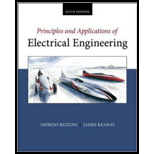
For each case shown below, derive the expression forthe current through a
a.
b.
c.
d.
Want to see the full answer?
Check out a sample textbook solution
Chapter 4 Solutions
Principles and Applications of Electrical Engineering
Additional Engineering Textbook Solutions
Electrical Engineering: Principles & Applications (7th Edition)
Fundamentals of Applied Electromagnetics (7th Edition)
Electronics Fundamentals: Circuits, Devices & Applications
Programmable Logic Controllers
Electric Motors and Control Systems
Engineering Electromagnetics
- Inductive Circuits Fill in all the missing values. Refer to the following formulas: XL=2fLL=XL2ff=XL2L Inductance (H) Frequency (Hz) Inductive Reactance ( ) 1.2 60 0.085 213.628 1000 4712.389 0.65 600 3.6 678.584 25 411.459 0.5 60 0.85 6408.849 20 201.062 0.45 400 4.8 2412.743 1000 40.841arrow_forwardAssume that the current flow through the resistor, IR, is 15 A; the current flow through the inductor, IL is 36 A; and the circuit has an apparent power of 10,803 VA. The frequency of the AC voltage is 60 Hz. ET ER EL IT IR15A IL36A Z R XL VA10,803 P VARSL PF Larrow_forwardA capacitor uses air as a dielectric and has a capacitance of 3 F. A dielectric material is inserted between the plates without changing the spacing, and the capacitance becomes 15 F. What is the dielectric constant of this material?arrow_forward
- Three capacitors having capacitance values of 20F,40F, and 50F are connected in parallel to a 60 - Hz power line. An ammeter indicates a circuit current of 8.6 amperes. How much current is flowing through the 40F capacitor?arrow_forwardA postage stamp mica capacitor has the following color marks starting at the upper left dot: yellow, violet, brown, green, no color, and blue. What are the capacitance value, tolerance, and voltage rating of this capacitor?arrow_forwardAssume that the voltage drop across the resistor, ER, is 78 V; the voltage drop across the capacitor, EC, is 104 V; and the circuit has a total impedance, Z, of 20 . The frequency of the AC voltage is 60 Hz. Find the missing values. ET ER78V EC104V IT IR IC Z20 R XC VA P VARSC PF Carrow_forward
- A postage stamp capacitor has the following color marks starting at the upper-left dot: black, orange, orange, black, silver, and white. What are the capacitance value and tolerance of this capacitor?arrow_forwardFind the equivalent Inductance for the following circuit shown below. L 0000 2.5 H OH 2 H 6 H 0.5 H elle 2 2 H oooo elle 2 Harrow_forwardProblem #3 Find the equivalent capacitance of the group of capacitors shown below. all steps t 5.00 µF 3.00 µF 2.00 AF 4.00 uF 3.00 µF 6.00 uF 7.00 uFarrow_forward
- A capacitor circuit carrying 12 mA is placed across a 9 V sine wave ac source. A resistor carrying 20 mA is connected in parallel with the capacitor. The total circuit magnitude of current is esc 233 mA 32 mA O 12 MA ! 1 20 mA Q A N ← 2 W S #3 C E D X C $ 4 R F G Search or type URL % 5 V T G ^ 6 MacBook Pro B Y H & 7 N U ☆ J * 00 8 M + - ( 9 K < O < ) O L ➡ P V : ; { [ + + 11 = ? 11 F } 1 delete returnarrow_forwardFor the circuit shown in the figure, the maximum voltage is 120 V, the angular frequency is 330 rev/s, and the inductor is 80 mH. The switch is closed at t = 0. 70 mH -momo Emax = 124 V E = Emax sin wt S a) What is inductive reactance? b) What is the maximum current? c) Calculate the magnitude of the current in the inductor at 10.0 ms.arrow_forwardA voltage of 10V RMS 520Hz is applied across a 20mH inductor. Calculate the RMS current through the inductor. 78.2mA RMS 153mA RMS 108mA RMS 221mA RMSarrow_forward
 Delmar's Standard Textbook Of ElectricityElectrical EngineeringISBN:9781337900348Author:Stephen L. HermanPublisher:Cengage Learning
Delmar's Standard Textbook Of ElectricityElectrical EngineeringISBN:9781337900348Author:Stephen L. HermanPublisher:Cengage Learning
